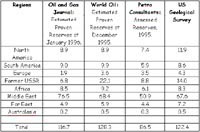
Different recent industry estimates of worldwide oil resource in units of GtC. (From: Odell, P. (1997) A Guide to Oil Reserves and Resources: Report to Greenpeace, p.1, Energy Advice Ltd, 1997, London. Original data are in (billion barrels) based on emission factors in the table and the conversion of 5.815 GJ/barrel of crude oil.)